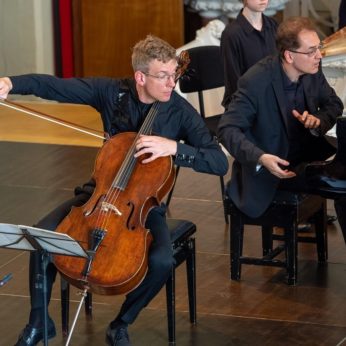Composer: Benjamin Britten (b. 1913 - d. 1976)
Performance date: 01/07/2019
Venue: St. Brendan’s Church
Composition Year: 1913 - 1976
Duration: 00:22:26
Recording Engineer: Gar Duffy, RTÉ
Instrumentation: vc, pf
Instrumentation Category:Duo
Artists:
Dénes Várjon -
[piano]
Johannes Moser -
[cello]

Benjamin Britten (1913-1976)
Cello Sonata Op.65
1. Dialogo
2. Scherzo-pizzicato
3. Elegia
4. Marcia
5. Moto perpetuo
On 21 September 1960 Benjamin Britten joined Shostakovich in his box at the Royal Festival Hall for the British premiere of the latter’s Cello Concerto; the soloist was the thirty-three-year-old Mstislav Rostropovich, for whom the Concerto had been written. Britten was overwhelmed by Rostropovich’s playing; Shostakovich describes him as bobbing up and down like a schoolboy and even nudging him with happiness at the music. Backstage Rostropovich attacked Britten there and then and pleaded with him to write something for the cello. The next day Britten offered to write him a Cello Sonata on condition it was premiered the following year at Aldeburgh with Britten as accompanist. It was Britten’s first important piece of purely instrumental music for fifteen years and it is, in part, a portrait of the exuberant musician for whom it was written, especially the tempestuous last movement, now high and expressive, now low and grumbling, now gay and carefree.
When the score arrived in Moscow the next February, it was a case of love at first sight. Rostropovich rushed off a telegram to Britten: ‘ADMIRING AND IN LOVE WITH YOUR GREAT SONATA. LOVE ROSTROPOVICH.’ First rehearsals took place in March when Rostropovich managed to squeeze a day in London between planes on his way to South America. It took four or five large whiskies to get them over their nervousness and then they ‘played and played and played’. The premiere took place at Aldeburgh in a programme that also included Debussy’s ironic sonata. The last two movements were repeated as an encore: we would gladly have heard the whole sonata again on the spot, wrote the Times critic, William Mann.
The five-movement structure recalls Shostakovich as well as the divertimento forms, which found such wonderful expression in Mozart and Beethoven. The first movement is in sonata form drawing every thing from the cello’s opening lyric hesitancies and the piano’s punctuation. The Dialogo title for the movement reminds us that Britten was primarily an opera composer and there is certainly the feeling of two people intensely conversing. The cycle of hesitant questioning, violent argument and peaceful conclusion is repeated in series through the traditional sonata-form structure of exposition, development and recapitulation. The haunting conclusion in the coda is particularly moving as the music vanishes into the cello’s harmonic series. The Scherzo will here recall Debussy’s dramatic and witty use of pizzicato in his Sonata. The Elegia begins with a restrained but sad melody that slowly builds to a climax of surprising power before the song ends with the cello’s full-throated singing of the melody one more time. The Marcia is a tribute to Shostakovich who enjoyed writing music of biting satire like this. The Moto perpetuo is every bit as exciting as the mercurial cellist for whom it was written. At the end it explodes into a tumultuous conclusion.
Francis Humphrys
Copyright © 2024 West Cork Music. All rights reserved.
Designed and developed by Matrix Internet